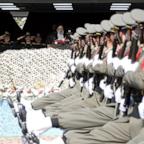Japan Tsunami Debris: Under Control or on the Brink of Disaster?
Debris field three times the size of the U.S. floating in the Pacific Ocean.
June 9, 2012 — -- Scientists estimate that the mass of debris from the Japanese earthquake making its way to the United States and Canadian coastlines is three times the size of the U.S.
While the government says the situation is under control, some experts insist there is no solid plan for "an event that is unprecedented in history."
This week, a dock from Japan washed up in Oregon. In recent months, other items, including a fishing boat, a motorcycle and a soccer ball, have made their way to the U.S. and Canada. And these items are just the beginning of what's to come.
The Japan Ministry of Environment estimated that 5 million tons of debris washed into the ocean after the tsunami that killed thousands of people. It said about 70 percent of the debris sank near the coast of Japan and the remaining 30 percent -- approximately 1.5 million tons of debris -- floated into the Pacific Ocean.
Curtis Ebbesmeyer, an oceanographer is Seattle who has been tracking ocean debris for most of his 40-year career, is unsatisfied with the government's response to the impending influx of debris.
"There's no plan," Ebbesmeyer told ABCNews.com. "Plans are being talked about, but they're fairly generic and they're basically all business as usual, and one thing that's clear is that this tsunami debris is unprecedented in recorded history."
Ebbesmeyer predicted that the bulk of the debris will reach the U.S. coast from Northern California to Alaska in October, with more to follow.
Ebbesmeyer was having a difficult time wrapping his head around the sheer enormity of the debris and wanted to give others a relatable way to think about the mass. One of the items he likes to work with is yellow rubber ducks.
Based on Ebbesmeyer's calculations and the conservative estimate of 1 million tons of debris, the weight of the debris floating in the Pacific is equivalent to the weight of 50 billion rubber ducks.
"We've got three months until we're deluged," he said. "It's past time for business as usual. We need to come up with some simple directives."
For 2012, the National Oceanic and Atmospheric Administration (NOAA) has $4.6 million devoted to marine debris and $618,000 of that amount is dedicated to the cleanup of the Japanese marine debris, according to NOAA.
"Marine debris has been an everyday problem long before the tsunami," NOAA spokeswoman Keeley Belva told ABCNews.com. "It's not a new problem."
Belva said NOAA is tracking the debris and has a section of its website dedicated to frequently updated information about marine debris, including guidelines for people who come across debris.
"We're encouraging people to continue going to the beach and doing things like that, but if they see debris that looks dangerous, we're asking them to act appropriately" by calling an emergency number of the Coast Guard, Belva said.
If citizens come across disposable or recyclable items, she said, they can help by picking them up and putting them in an appropriate place.
NOAA is also working with commercial shipping companies who notify them when they spot potential debris and the Japanese consulate so that items of great monetary or personal value could potentially be returned to their owners. Ebbesmeyer does not think the efforts are enough, calling them "generic."
"They need specific community plans. They need to work with the citizens," he said. "Which landfills can they take [the items] to in their communities?"




